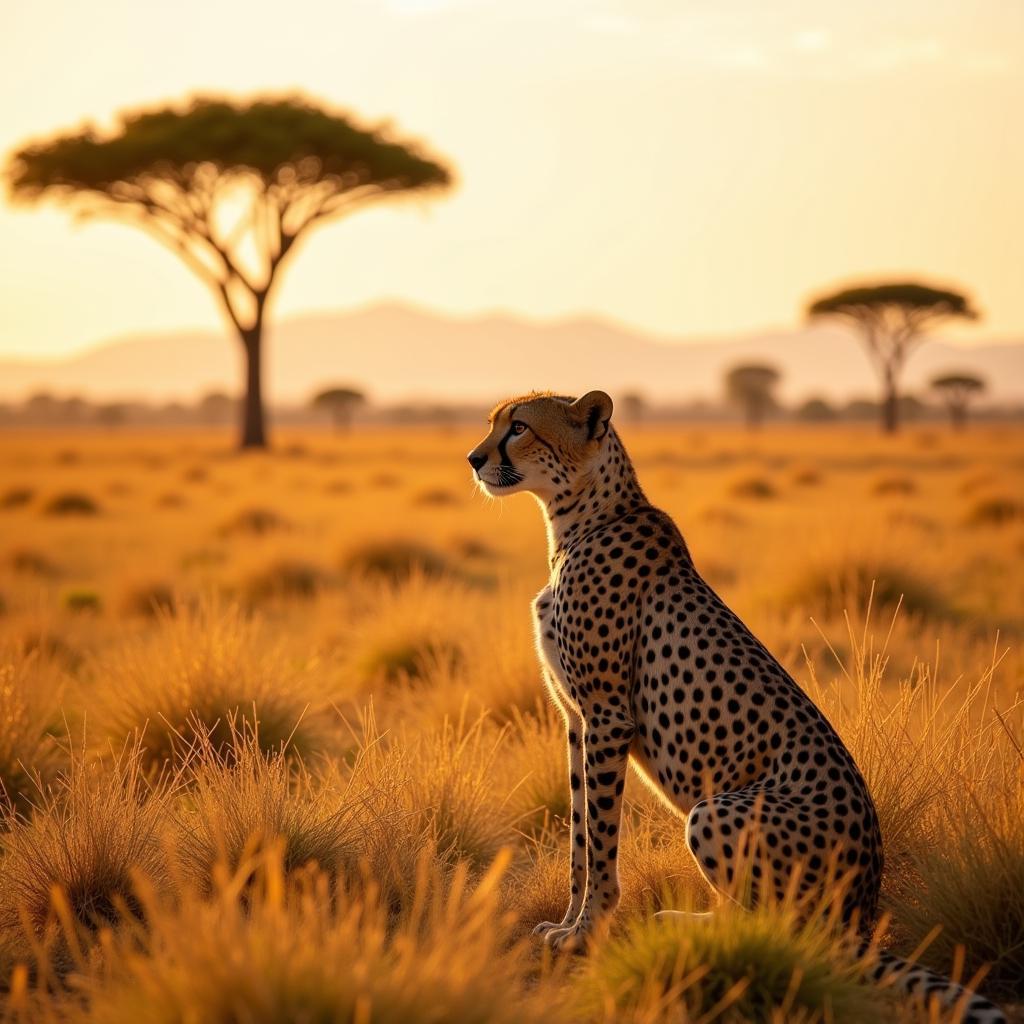Unveiling the African Cheetah Habitat: Where Speed Thrives
The African cheetah, a symbol of raw power and grace, is intrinsically linked to the diverse landscapes it calls home. Understanding the African Cheetah Habitat goes beyond simply knowing where they live; it’s about appreciating the intricate relationship between this magnificent creature and its environment.
A Tapestry of Habitats: From Grasslands to Shrublands
Cheetahs are remarkably adaptable creatures, thriving in a variety of habitats across Africa. Their range spans from the savannas of East Africa, with their iconic acacia trees and vast grasslands, to the dry, arid regions of Southern Africa, where sparse vegetation and rocky outcrops dominate the landscape.
Savannas: A Haven for Prey and Predator
The savannas of East Africa, particularly in Kenya and Tanzania, are considered prime African cheetah habitat. These areas offer a perfect blend of open grasslands, ideal for high-speed chases, and scattered trees and shrubs, providing shade from the scorching sun and vantage points for spotting prey.
 Cheetah on the Savanna
Cheetah on the Savanna
Arid Landscapes: Testing the Limits of Adaptation
In Southern Africa, cheetahs have adapted to harsher conditions, inhabiting arid regions and dry woodlands. These areas, while lacking the abundance of prey found in savannas, offer unique challenges and opportunities for these resilient felines.
The Importance of Prey: Sustaining the Speedster
The availability of prey is the single most crucial factor determining the suitability of an African cheetah habitat. Cheetahs primarily feed on gazelles, impalas, and other small to medium-sized antelopes, which are abundant in the grasslands and savannas.
[african grazing animals]
A Balancing Act: Competition and Coexistence
However, cheetahs face stiff competition from other apex predators like lions, leopards, and hyenas, which often steal their kills. This competition influences the distribution and behavior of cheetahs within their chosen habitat, forcing them to be strategic hunters and vigilant protectors of their hard-earned meals.
[african animals wikipedia]
Threats to the African Cheetah Habitat: A Call for Conservation
Sadly, the African cheetah habitat is under increasing threat from human activities. Habitat loss due to agriculture, infrastructure development, and human-wildlife conflict is pushing cheetahs into smaller and more fragmented areas, jeopardizing their survival.
Climate Change: An Emerging Threat
Climate change is further exacerbating these challenges, leading to more frequent and severe droughts that affect prey populations and alter the delicate balance of the ecosystem.
Protecting a Legacy: Ensuring the Future of Cheetahs
Conserving the African cheetah habitat is paramount to the survival of this iconic species. Efforts are underway to establish protected areas, promote sustainable land management practices, and mitigate human-wildlife conflict.
[south african cheetah]
The Role of Ecotourism: Raising Awareness and Support
Ecotourism plays a crucial role in conservation by generating revenue for local communities and raising awareness about the plight of cheetahs and their habitat. By supporting responsible tourism initiatives, we can all contribute to the preservation of this magnificent creature for generations to come.
[african antelope o]
Conclusion: A Shared Responsibility to Safeguard a Treasure
The African cheetah habitat, a tapestry woven with grasslands, woodlands, and arid landscapes, is not merely a backdrop but a vital component of the cheetah’s survival. As we marvel at the cheetah’s speed and grace, let us also recognize our responsibility to protect its fragile habitat and ensure that future generations can witness the thrill of the chase in the wilds of Africa.
FAQs: Delving Deeper into Cheetah Habitats
What is the preferred habitat of a cheetah?
Cheetahs thrive in open grasslands and savannas, particularly in East Africa, where prey is abundant and their speed gives them an advantage.
How do cheetahs adapt to arid habitats?
Cheetahs in arid regions have adapted to conserve water and utilize available resources efficiently. They obtain moisture from their prey and can go for extended periods without drinking.
How does human activity impact cheetah habitats?
Habitat loss, fragmentation, and human-wildlife conflict are major threats to cheetah habitats, limiting their range and access to resources.
Do you want to learn more about the fascinating world of African animals?
Check out these related articles:
[african animals pictures]
Get in touch!
For any assistance or inquiries, please contact us:
- Phone: +255768904061
- Email: kaka.mag@gmail.com
- Address: Mbarali DC Mawindi, Kangaga, Tanzania.
Our dedicated customer support team is available 24/7 to assist you.


